
Special Online Screening of “MAM Screen”
“Mori Art Museum DIGITAL” is presenting special online screenings of video works featured in the Mori Art Museum’s “MAM Screen” series.
In addition to two works from MAM Screen 013: Mounira Al Solh premiered online prior to the actual on-site screening, selected works from the past “MAM Screen” series are now brought back online for the limited-time, encore screening.
Online Encore Screening
- MAM Screen 007: Yamamoto Atsushi *** NEW ***
- MAM Screen 011: Takata Fuyuhiko
- MAM Screen 012: Chen Chieh-Jen
Online Sneak Preview of MAM Screen 013: Mounira Al Solh
Online Screening of MAM Screen 007: Yamamoto Atsushi
Screening Period: Wednesday, June 17 - Saturday, August 15, 2020
The third edition of “MAM Screen” Encore Screening features eight works by Yamamoto Atsushi for a limited time. All works were previously presented at MAM Screen 007: Yamamoto Atsushi.
Yamamoto Atsushi (b. 1980) has created 200 video works to date, ranging from documentaries to works of fiction and experimental stories. In recent years, he participated in How to Live #2 at Roppongi (ShugoArts, 2018) and Noise of Silence: Japanese Art Now (Golden Thread Gallery, Belfast, UK, 2019). He was also showcased solo at Art Center Ongoing (Tokyo, 2020).
Yamamoto’s work frequently features anonymous locations such as suburbs and new town developments, with the artist himself playing the role of young idlers or irregularly-employed workers, which is related to Yamamoto’s upbringing in an ordinary household near Tokyo. Each work reflects the sincerity of the artist whereby he attempts to face the reality before him. Showcasing his early short pieces and his recent films, the program dives into the diverse and fascinating world of his video works.
Commentary by the Artist and Curator
The encore screening features works selected from those that were previously presented at MAM Screen 007 in 2017. The oldest work dates back to 2008 (12 years ago), while the latest work is from 2013 (7 years ago).
Considering that I started producing video works in 2003, the selection could be regarded as spanning the mid-point of my artistic career thus far. While being thankful for the opportunity to introduce these works once again, in retrospect I feel that the underlying root of my work has remained unchanged.
I began producing video works in Berlin, Germany, with the theme of “solitude and identity,” and upon returning to Japan, had dealt with reacting and expressing feelings of “entrapment” and “frustration” surrounding our society. Thereafter, until recently, my interests had shifted towards “storytelling” and “narratives.”
I think it is only natural for my works to keep changing, as my own interests and ways of expression have changed along with changes in the environment and society. On the other hand, my works that are conceived as the final output always seem to pose the question: “what kind of world do we live in?” (I’ve come to this point due to not being able to change my anthropocentric and self-centered ways of thinking)
Even under current circumstances in which we are forced to change the ways we look at the world, this basic stance remains unchanged. Although this is by no means an answer, one thing I can say is, it is in antinomies such as “the possibility of impossibility” that I’m sensing the universality of the world.
In the case of the featured work The Real World 8-bit (2011), I was conscious of the words of Charlie Chaplin: “Life is a tragedy when seen in close-up, but a comedy in long-shot.” (The idea is based on my childhood experience of being unable to gain a sense of real pain at all in the low-resolution world of Nintendo Entertainment System [NES] video game software) In the sense that “life is both a tragedy and comedy,” anything can easily be turned around if we change our perspective. In this respect, what came to mind when thinking about our current reality that is permeated by the influences of the coronavirus pandemic, were the words “changing/unchanging.”
I find myself slightly at odds with the term “new normal.” I don’t wish to criticize, but society has continued to change now and in the past, and therefore it could be said that we have always lived in accordance to the “new normal.” I believe that it is simply the nature, degree, and speed of change that’s different, and our everyday has indeed been both “changing and unchanging.” I find myself somewhat puzzled by having to draw the line between “new” and “old” amidst the continuation of everyday life.
My honest impression is that as an artist who has consciously engaged in producing work in the realm between “changing/unchanging (seeking universality while responding to the times and environment we are placed in),” the way in which my work is perceived is also that “changes/remains unchanged.” I would be happy if viewers would embrace as it is, this paradox of there being “answers/no answers” presented. If “art means to live,” I feel that the appeal of my art is indeed its antinomy and ambiguity.
-- Yamamoto Atsushi
When I revisited Yamamoto’s video works on this occasion, I found my eyes drawn to the trivial things that were captured in the corners of the screen. From waterways in farm fields, to power wires in residential areas, and weeds growing in parking lots, the works preset mundane suburban landscapes that we often don’t pay close attention to. However, when going back and forth between their details and entireties, I realized that it is these things that indeed instill Yamamoto’s works with a rich sense of reality.
Everyday life that is overlooked has often been depicted in video works within the realm of contemporary art. An example is All My Life (1966) by Bruce Bailey (1931-2020) who had continued to produce experimental video works since the 1960s. Through such works, we are made aware that everyday trivial matters are such an important factor in establishing our world.
In thinking about our lives and the world in the post-corona era, I feel that Yamamoto’s question of “what kind of world do we live in?” as well as ideas on “changing/unchanging” are that which have become increasingly significant. The world is always changing, and at the same time remains unchanged. Through Yamamoto’s works we can understand the importance of living in an ever-changing world while turning our eyes to the valuable and the critical that do not change.
-- Tokuyama Hirokazu (Associate Curator, Mori Art Museum)
Yamamoto Atsushi 2dogs
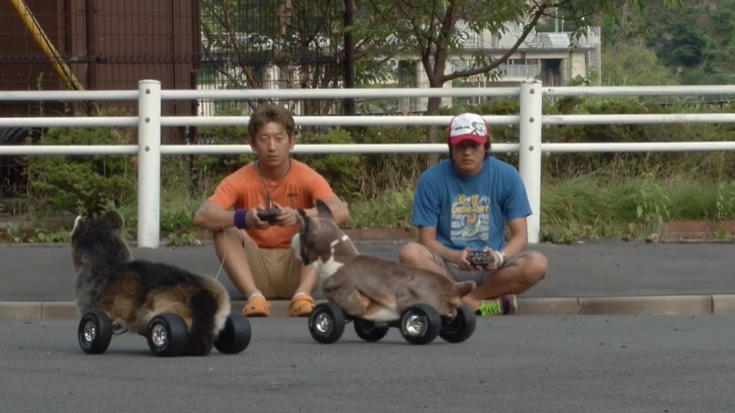
Video
2 min. 51 sec.
In this work, two young people expressionlessly play with a couple of radio-controlled toy dogs. In how the body of the dog tilts and the wheels obviously protrude from underneath its feet, we see that the toy is put together casually, conveying no sense of attachment to the toy dogs from the pair nor to what they are doing. This work seems to reflect the personal experience of the artist, who spent his adolescence in suburbia. It humorously extracts the unfocused frustration of youngsters who hang out in convenience store parking lots or on vacant land, doing meaningless things to amuse themselves and pass the time.
Yamamoto Atsushi The Blue Monster
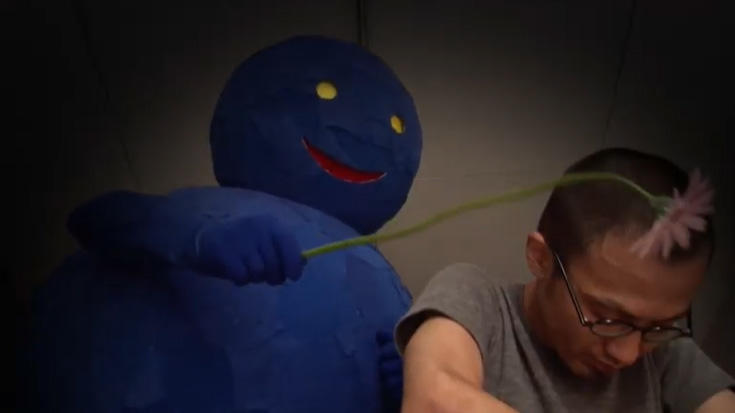
Video
3 min. 39 sec.
This work is inspired by an anime that was playing at a shopping mall store. In the anime, the blue monster comforted a sad princess, but here the blue supernatural creature, played by Yamamoto himself, consoles a middle-aged man. Set in a squalid, abandoned bar, melancholy pervades the atmosphere of the work. But this sorrow has a vivid realism lacking in a beautifully depicted fantasy world. What is self-evident is that when the format of fantasy is applied to the reality of Yamamoto himself, the framework ceases to function. Perhaps Yamamoto’s inquiry lies in the absurdity of implementing this nonetheless.
Yamamoto Atsushi The Real World 8-bit
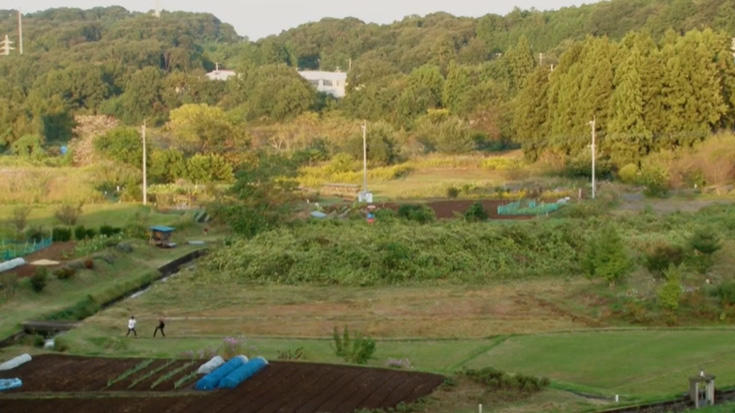
Video
3 min. 17 sec.
This video work comprises a live-action recreation of the 8-bit* fighting games such as Kung-Fu Master and Yie Ar Kung-Fu for the Nintendo Entertainment System (NES). By filming from a far distance, the subjects appear small, imitating the low-resolution look of video game software. Compared to recent fighting games that use 3D graphics, 8-bit violence and death is shoddily depicted and the world does not feel real. Yamamoto utilizes this unreality to express a certain view of humanity as encapsulated by the words of Charlie Chaplin, who greatly influenced the artist: “Life is a tragedy when seen in close-up, but a comedy in long-shot.”
* 8-bit is a type of microprocessor used in a computer CPU. 8-bit CPUs were widely used in the 1970s and 1980s in home computers as well as game consoles such as the Nintendo Entertainment System.
Yamamoto Atsushi About the Possibility of Impossibility
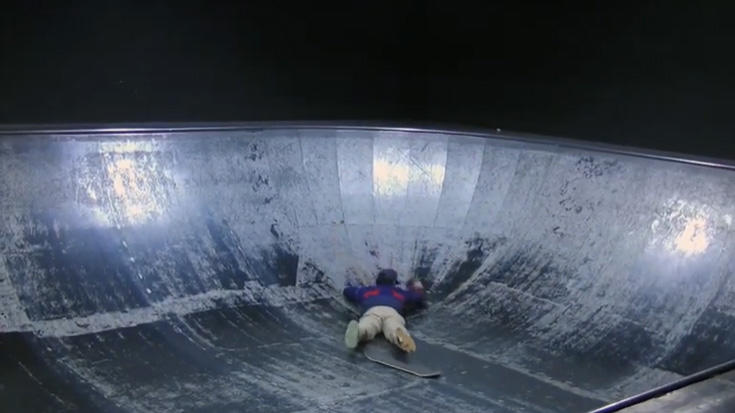
Video
12 min. 21 sec.
This video shows Yamamoto grappling with the task of skating on a skateboard with no wheels. You can neither skate nor do tricks with a skateboard that has no wheels. You cannot move forward; all you can do is to stay where you are. But while not moving forward is seen as something negative at a glance, could it potentially contain any new possibilities? The work seemingly inquires into this impossibility.
Yamamoto Atsushi Crossing a Mountain
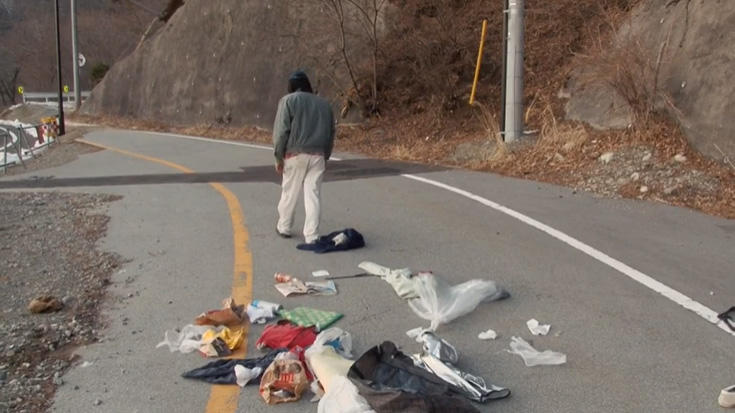
Video
3 min. 3 sec.
A man wearing a suit suddenly attacks a homeless person crossing a mountain. This artwork depicts the situation where the haves rob the have-nots. At the root of this is the simple message that we must keep on walking in our lives, no matter what difficulties arise. Given, though, that it was filmed on March 12, 2011, the day after the Great East Japan Earthquake, the work is also highly significant for the artist.
Yamamoto Atsushi I have something to talk to you about.
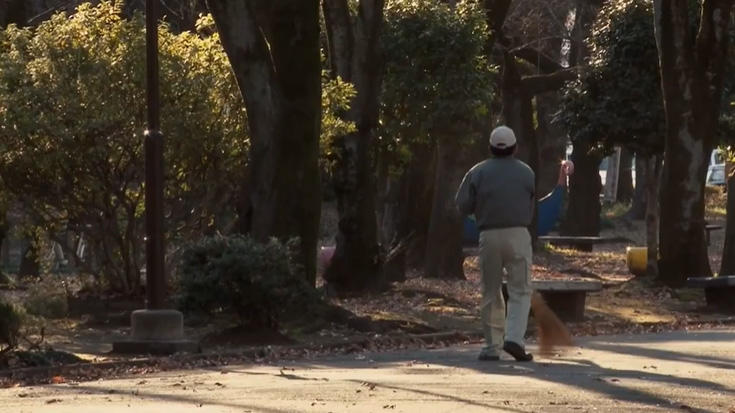
Video
1 min. 42 sec.
In this work inspired by elderly men that Yamamoto sees every morning on his way to work, an old man played by Yamamoto sweeps rhythmically with a broom. The act had become a part of his daily routine and rather a soothing landscape to him, by repeating the same actions every day - even though such an act as sweeping up the leaves that fall daily at the end of autumn seems futile or endless. The work may portray the potential for any actions to be accepted by the modern society.
Yamamoto Atsushi A Beautiful Burning Stone
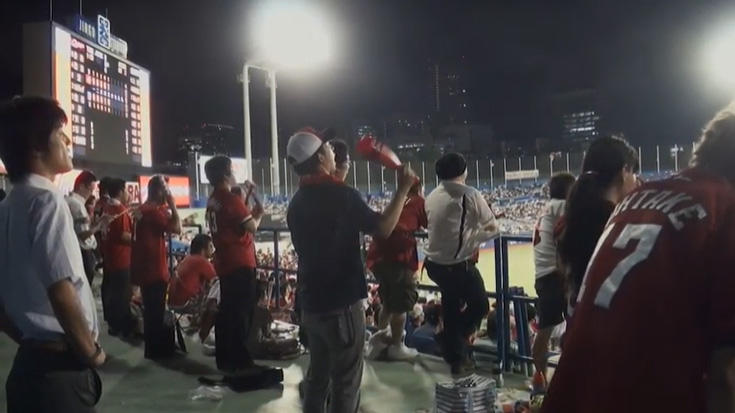
Video
9 min. 31 sec.
Even if an ordinary life just continues on, it can still be satisfying if we have something we really like. The job of the protagonist here is to control traffic, but he is also a massive fan of the Hiroshima Toyo Carp professional baseball team. Starting from the act of waving the arm that is shared in both his professional and private lives, the work shows what lies at the core of his life. Both in the baseball stadium and at work, the man continues his simple movements in which we can catch glimpses of his quiet passion. Evoking such dualisms as “the sacred and the profane,” or yin and yang, the minimal expressions question if there is a truth perhaps hidden in the things we repeat in our daily lives, and suggest to us the beauty of living and the assured happiness of life.
Yamamoto Atsushi Sunny days in Thailand
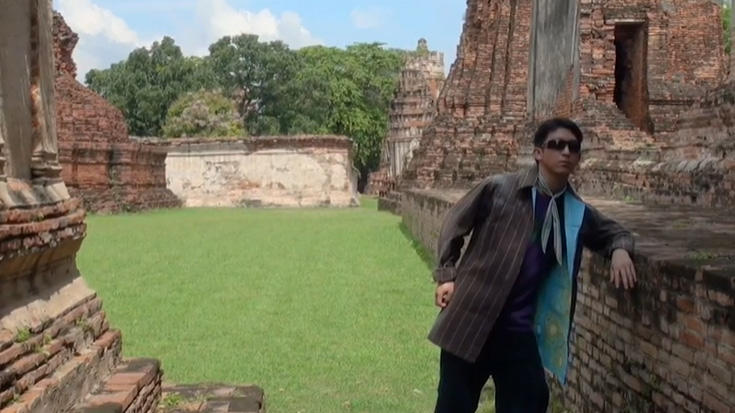
Video
12 min. 56 sec.
This work is about a fictional superhero trying to make Thailand, which is known as the “land of smiles,” into the “land of the sun.” The inside of the man”s jacket features the sun depicted in the style of Vincent van Gogh. Conscious of people looking at him, he opens his coat to allow glimpses of the sun. The work climaxes with the man, when caught in a squall, seizing the chance to reveal the “sun,” but no one takes any notice. If we presume this figure, who endeavors to accomplish an act of God by transforming the country into the “land of the sun,” to be a genuine superhero, we become aware of the critical perspective latent in the work that suggests the arbitrariness of justice and the relationship between heroism and narcissism.
MAM Screen 007: Yamamoto Atsushi
Period: 2017.11.18 [Sat] - 2018.4.1 [Sun]
Organizer: Mori Art Museum
Curated by: Tokuyama Hirokazu (Associate Curator, Mori Art Museum)
* Exhibition webpage: https://www.mori.art.museum/en/exhibitions/mamscreen007/
Online Screening of MAM Screen 011: Takata Fuyuhiko
Screening Period: Wednesday, June 3 - Friday, July 31, 2020
The second edition of “MAM Screen” Encore Screening features three works by Takata Fuyuhiko: Dream Catcher (2018/2019); WE ARE THE WOMEN (2013/2019); and The Great Stone Project (2007-) for a limited time. All three works were previously presented at MAM Screen 011: Takata Fuyuhiko.
Takata Fuyuhiko (b. 1987 in Hiroshima) deals with themes as diverse as religion, myth, fairytales, gender, trauma, sex, and the BL (“Boys’ Love”) manga genre, in humorous, occasionally erotic videos with a pop sensibility. Locations vary from his home studio, to university campuses and the outdoors. Sets with a wonderfully handmade aesthetic add to the appeal of his work. In recent years, he participated in MOT Annual 2016: Loose Lips Save Ships (Museum of Contemporary Art Tokyo) and was showcased solo at Kodama Gallery (Kyoto, 2013 / Tokyo, 2016), Art Center Ongoing (Tokyo, 2012, 2014 and 2017).
The wide range of themes that the artist deals with constitutes a form of caricature in which he uses exaggerated humor to analyze and criticize things that are important to human society in any age. His art is particularly critical of traditional concepts of masculinity and femininity that need to be reconsidered in today’s society. This characteristic seems to underlie Takata’s interventions from a variety of perspectives, from Cupid the god of love, to the narcissistic god Faunus, a man in drag, and the birds playing a supporting role by unobtrusively watching the lovers who are the main characters. In this way, Takata raises a range of issues in a form that is carefully constructed, although outwardly appearing nonsensical.
Commentary by the Artist and Curator
On this occasion I was given the opportunity to present an online screening of my video works from among those featured last year in Mori Art Museum’s “MAM Screen” series. I have selected three works with hopes to introduce as many variations as possible from my oeuvre.
Of these, I, in particular, would like to take a moment to touch upon the work Dream Catcher, which is based on the fairytale Rapunzel. I created the work based on my own contemporary interpretation of the famous tale of a young damsel in distress, who remains imprisoned in a tower as she awaits her prince to come.
Not only in the case of Rapunzel, but temporary withdrawal or confinement from the outside world is a motif that is observed here and there in old tales and mythology, like that of Sleeping Beauty, as well as Iwatogakure (the hiding of Amaterasu Omikami, the sun goddess, in the heavenly rock cave) in Japanese mythology. I have found myself strongly attracted to such tales. This is because I am an artist who, like Rapunzel, confines myself to my apartment where I live alone, and while paying attention to mental aspects, that is, issues of self-consciousness that mushroom in this context, have been intent on creating expressions that solely take place within a single room.
While artistic expressions centered on collectiveness and/or communication have been attracting attention, I at times feel a certain sense of guilt in continuing to engage with these introverted themes and methods. At the same time, however, given the increasing number of single-person households, as well as issues of social withdrawal and solitary deaths, and in attempting to imagine the minds of such individuals in their closed worlds, I indeed feel that my work in a way serves an image characteristic of our current times.
As a result of the coronavirus pandemic, people were semi-forced to a time of confinement. To be honest, for me it was somewhat of a comforting experience. I felt relieved having escaped from the need to engage in communication. I believe there are a surprisingly large number of people who feel the same way as I do, especially among those who feel oppressed from society, or that they have no place.
I would like to continue paying attention to these Rapunzels of the contemporary times. How is their self-consciousness hurt within the confines of small rooms to which they seclude themselves, how does it run wild, and then break loose to get connected with the outside world (in a twisted way)? In the midst of this global crisis, I in this manner am led to rethink my own standing.
-- Takata Fuyuhiko
Including Dream Catcher which seems to symbolize the “Stay Home” movement in the time of the coronavirus outbreak, Takata and I together selected three works that illustrate a wide breadth of themes - from the position of women in society to aspects related to religion.
The often humorous and ironical works, in spite of their seemingly pop and light-hearted nature, lead us to contemplate a number of things. Having read Takata’s comment, I was reaffirmed that this was because rather than as a response to political correctness or current affairs, the themes he deals with have been born through his excruciating efforts to come face-to-face with himself, or confronting timeless, mythical matters or art history. It is indeed interesting that as a result, the works end up reflecting themes related to current and topical issues.
It made sense to me when I heard that Dream Catcher in part draws inspiration from Louise Bourgeious’ “Spiral Woman” series that depict a woman being wrapped around in layers of something. I am looking forward to seeing what kind of work Takata will create in the future, as an artist who doesn’t lose his standing in any disasters or crises, and what is more, as an artist who has a self-consciousness that spirals while he confronts himself.
-- Tsubaki Reiko (Curator, Mori Art Museum)
Takata Fuyuhiko Dream Catcher
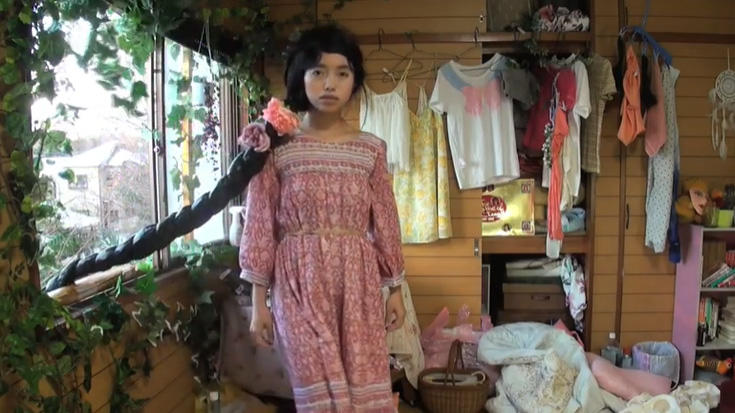
Video
5 min. 25 sec.
Featuring: Endo Mai
Based on the fairytale Rapunzel, this work is a humorous and ironic depiction of the meaninglessness of girls and single women believing in “a knight in shining armor,” an ideal Mr. Right who will one day come and rescue the fair maiden. The video alternates between a miniature set and a performance with the artist Endo Mai playing the damsel in distress.
Growing tired of waiting for the prince in her tower, Rapunzel sings a parody of the song Some Day My Prince Will Come, composed by Frank Churchill. With extremely long, braided hair that extends far beyond her tower, Rapunzel attempts to reel in the prince, who is still out of sight, by spinning round and round. However, as she throws herself into the task, she becomes wrapped in layer after layer of hair, eventually becoming transformed into a pathetic black clump unable to achieve her original purpose.
Meanwhile, the violent, haphazard meanderings of the maiden’s hair have rendered the world outside her tower a chaotic mess, resembling the aftermath of a natural disaster.
Takata Fuyuhiko WE ARE THE WOMEN
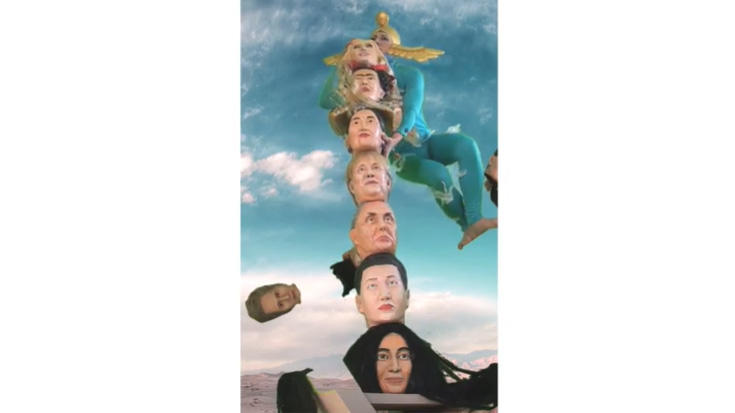
Video
8 min. 47 sec.
In this video, the artist attempts to create a totem pole by piling up the heads of strong, iconic women in history, including Frida Kahlo, Madonna, Margaret Thatcher, Elizabeth I, and Judith of the Catholic Old Testament. A goddess-like character at the top of the totem pole, played by Takata, attempts to balance everything with the head in an attempt to stack up all the heads and to keep the tower from collapsing, abiding by the ambrosial voice reverberating from somewhere indicating whose head Takata’s goddess character should get with her feet and place on top. The voice is a synthesized version of the artist’s mother who is of feminist thoughts, but it comes crashing down before she can stack up all the heads
The totem pole that approaches completion, just to end up falling short, appears to be an allusion to the continued existence, due to gender inequality, of limitations and difficulties that women face in attempting to take their place in contemporary society, despite the progress made in the liberation and empowerment of women.
Takata Fuyuhiko The Great Stone Project
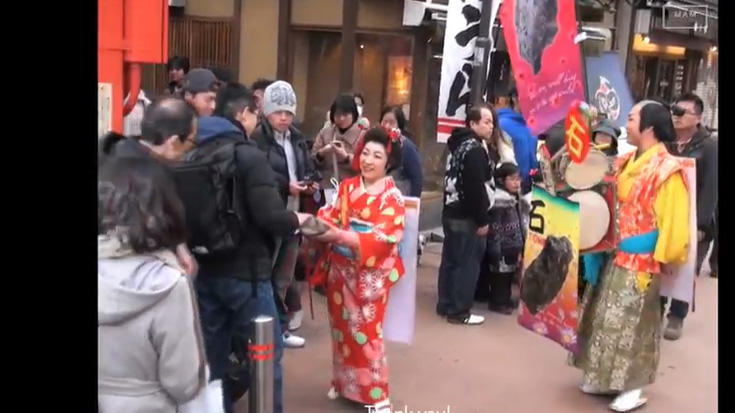
Video
8 min. 9 sec.
In spring 2007, the artist picked up a “mundane stone” - a chunk of concrete, to be precise - from a construction site in his neighborhood. This project attempts to turn a perfectly ordinary stone into a wondrous stone possessing more experience than any other stones in the world. He does this by subjecting it to various experiences, with the stone playing the leading role in videos and performances. So far, these include being strapped to someone’s back and crawled around a shopping area along with the person, being wrapped in raw meat and left in the forest to be infested with maggots, being cursed in a ritual by what appears to be a savage tribe, and being hyped by a band of chindonya street performers (traditional advertisers) parading through the streets. The project results in an omnibus of short clips of two to three minutes each, which the artist plans to continue creating from time to time.
MAM Screen 011: Takata Fuyuhiko
Period: 2019.6.20 [Thu] - 10.27 [Sun]
Organizer: Mori Art Museum
Curated by: Tsubaki Reiko (Curator, Mori Art Museum)
* Exhibition webpage: https://www.mori.art.museum/en/exhibitions/mamscreen011/
Online Screening of MAM Screen 012: Chen Chieh-Jen
Screening Period: Wednesday, May 20 - Friday, July 31, 2020
The first edition of “MAM Screen” Encore Screening features five works by Chen Chieh-Jen: Factory (2003, Collection: Mori Art Museum); The Route (2006, Collection: Mori Art Museum); Realm of Reverberations (2014/2019); Star Chart (2017); and A Field of Non-Field (2017). All five works were previously presented at MAM Screen 012: Chen Chieh-Jen.
Born in 1960 in Taiwan, Chen Chieh-Jen is acknowledged as one of the most prominent artists of his generation. He is known for producing video works mainly in collaboration with activists and social groups who live at the fringes of society. Often filmed in the architectural relics of previous government policies, Chen’s dramatic reportage, which fuses fiction and archival footage, examines the vulnerability of human existence as well as dignity. His works evoke the trauma, hardships, and various forms of imprisonment and abandonment that people have experienced throughout Taiwan’s turbulent history - from the Japanese colonial rule, the imposition of martial law, to the implementation of neo-liberalism as its economic policy.
Chen has had solo exhibitions in various institutions including Taipei Fine Arts Museum (2010), Museo Nacional Centro de Arte Reina Sofia (Madrid, 2008). His works have been exhibited at São Paulo Biennale (1998, 2010), Venice Biennale (1999, 2005, 2009), and Liverpool Biennale (2006). In 2018, he was named the Artist of the Year at the Award of Art China.
Chen Chieh-Jen Factory
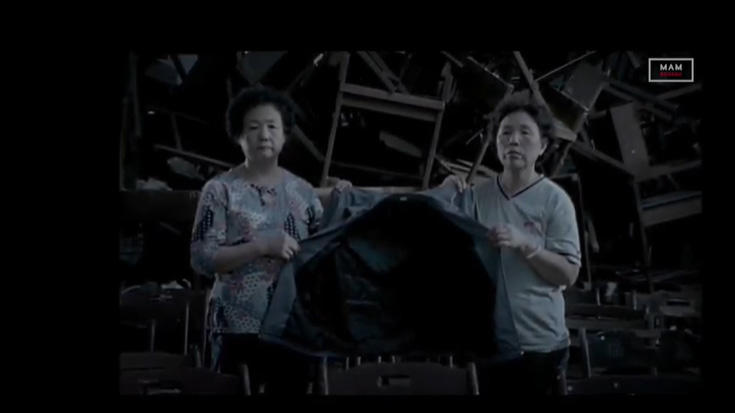
Super 16mm transferred to DVD, color, silent
31min. 9 sec.
Collection: Mori Art Museum, Tokyo
This work centers on a group of unemployed female textile laborers reenacting their duties in the abandoned factory where they once worked. The garment factory was founded in 1969 and it helped grow Taiwan’s industry and its export economy. However, the factory closed down in the mid-1990s, a decade after the government reconstructed its economy through market deregulation and neo-liberalist trade policies. Having laid off its employees without meeting financial obligations, the investors of the factory relocated its operations overseas for cheaper labor. In 2002, Chen met with these women, who had been forced into long-term unemployment and had been protesting for several years, to discuss their shared plight. This work is a product of their meeting.
Chen Chieh-Jen The Route
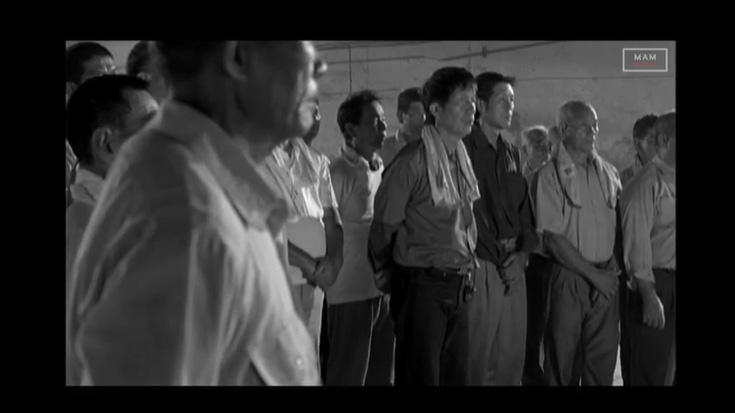
Super 35mm transferred to DVD, color & black-and-white, silent
16 min. 45 sec.
Collection: Mori Art Museum, Tokyo
Japanese subtitles: Okumura Yuki
This work is based on the Neptune Jade incident and the international dockworker’s movement. In 1995, under the British government’s privatization policy, hundreds of unionized dockworkers were fired in Liverpool, igniting a transnational waterfront strike led by the International Longshore and Warehouse Union (ILWU).
Inspired by this international network of solidarity, Chen collaborated with contemporary dockworkers of Kaohsiung in Taiwan to secretly stage a simulated protest. The video is fictional in premise, nonetheless conveys these dockworkers’ hope to forge solidarity across temporal and geographical boundaries.
Chen Chieh-Jen Realm of Reverberations (single-channel edition)

Video, black-and-white, sound
59 min. 47 sec.
Japanese subtitles: Okumura Yuki
Assistance with Japanese subtitles: Iwakiri Mio
Cooperative production with Taiwan Public Television Service (PTS)
This work is based on the history of the “Losheng Sanatorium,” established in Taiwan during the Japanese colonial period to quarantine leprosy patients. In 1961, fifteen years after the end of the Japanese rule, the policies against those inflicted with the condition were abolished, however, many declined to leave the sanatorium and continued to live there as their ‘home.’ In 1994, it was announced that a metro depot would be built on the grounds of the sanatorium, necessitating the demolition of the facility and relocation of the patients. The plan brought about an intense debate and later, a preservation movement.
Divided into three parts, the work explores the sanatorium’s history from different perspectives: a sanatorium resident, a young activist, and a fictional political prisoner who takes the audience through Taiwan’s history. Originally created as a four-channel video installation, the work is edited into a single-channel video piece for MAM Screen 012: Chen Chieh-Jen.
Chen Chieh-Jen Star Chart
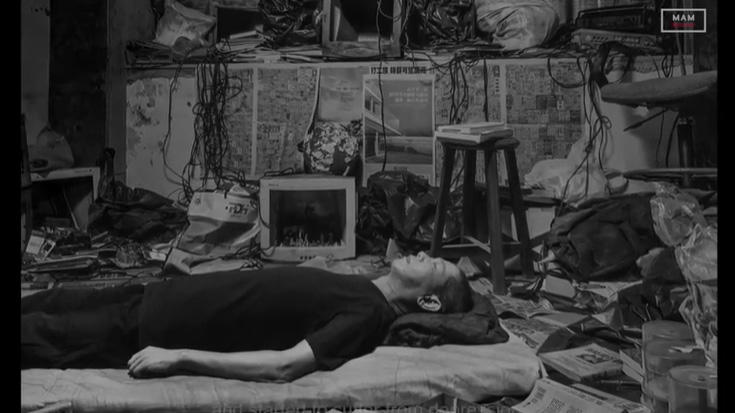
Video, black-and-white, silent
3 min. 50 sec.
Star Chart is composed of a series of black-and-white photographic images that Chen shot at his brother’s apartment. Having been unemployed for several years following the 1997 Asian financial crisis, his brother attempted to commit suicide owing to severe depression. Chen explains that, after surviving the incident, his brother began “collecting and organizing alternative knowledge” by converting his apartment “into an archive for images and text.” While the meaning of this collection is never elaborated, it nonetheless embodies one’s will to construct a vast knowledge system that is free from conventional worldviews. This work serves as a preface to A Field of Non-Field.
Chen Chieh-Jen A Field of Non-Field
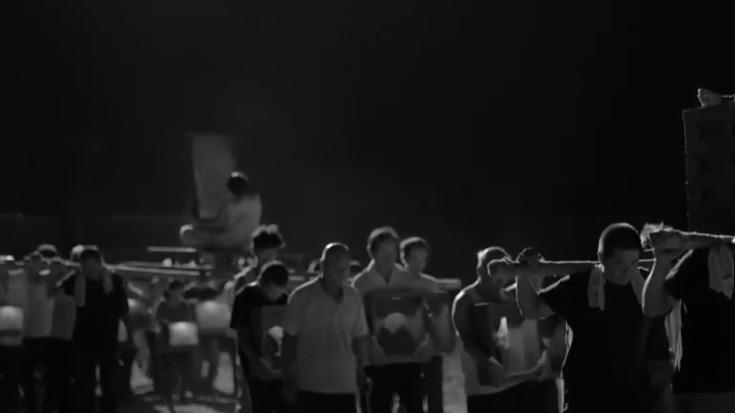
Video, color/black-and-white, sound
61 min. 7 sec.
Japanese subtitles: Okumura Yuki
“In our increasingly atomized and alienated capitalist society, I believe lo-deh sao still has the power to inspire,” Chen has said. Lo-deh sao is a pre-industrial form of theater in Taiwan that consists of simple opera and parade performances organized by the people of farming villages during the non-growing season. In this theater, villagers are offered opportunities to transcend their social roles by portraying multiple characters, such as farmers, artists, and mythical figures.
Conceived as a contemporary version of lo-deh sao, this piece shows a group of actors, who are actual workers, the unemployed, and activists, performing what seems like a funeral procession for a man who has attempted suicide. Their identities and relationships are interconnected but in gradual change, enabling them to transform their bodies into a richer source for alternative imaginary realms.
MAM Screen 012: Chen Chieh-Jen
Period: 2019.11.19 [Tue] - 2020.3.29 [Sun]
Organizer: Mori Art Museum
Curated by: Yahagi Manabu (Assistant Curator, Mori Art Museum)
* Exhibition webpage: https://www.mori.art.museum/en/exhibitions/mamscreen012/
Online Sneak Preview of MAM Screen 013: Mounira Al Solh
Screening Period: Tuesday, April 28 - Friday, July 31, 2020
As the opening of MAM Screen 013: Mounira Al Solh has now been postponed for the measures against the new coronavirus (COVID-19), we are introducing two works entitled Rawane’s Song (2006) and As If I Don’t Fit There (2006) online prior to the actual on-site screening.
Mounira Al Solh (born 1978 in Beirut, Lebanon) has been working internationally, based both in Europe and her native country Lebanon. In recent years, she participated in the 56th Venice Biennale (2015) and documenta 14 (Kassel, Germany, 2017).
Al Solh offers an affectionately humorous take on everyday events, small stories, and episodes drawn from the lives of women in a contemporary society wracked by political and religious conflict and by refugee issues. Using a documentary style, she occasionally interweaves the content with fiction and fantasy with intent, and frequently employs methods such as “monologue” and “narration.”
At on-site MAM Screen 013, four video works in total including two early works mentioned above will be shown. We hope you would enjoy the video online first; and later all four works on larger screen by returning to the Museum once it reopens.
Mounira Al Solh Rawane’s Song
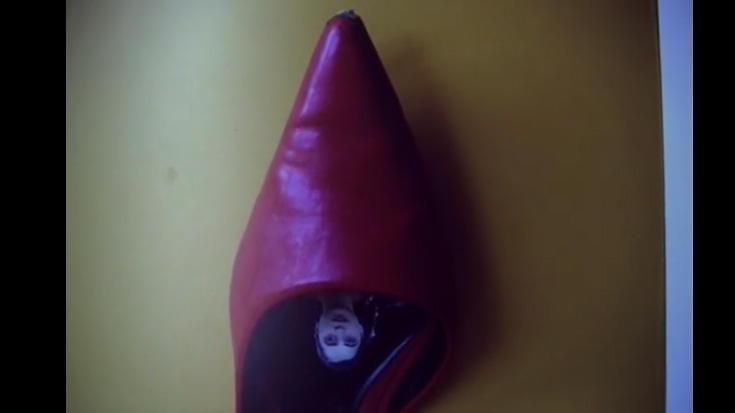
Video
7 min. 19 sec.
Courtesy: Sfeir-Semler Gallery, Beirut/Hamburg
The work portrays the concerns of a fictional artist in Lebanon who has made a conscious decision to avoid war-related topics at a time when so many works produced in the country took war as their theme.
The character in this video work, played by Al Solh herself, walks around an artist studio and describes pulling out of documentary festivals she had entered. Ironically, as the story progresses, it becomes clear that she will eventually end up talking about the war anyway. It is easy to see the struggle of the young artist with little personal recollection of the Lebanese Civil War wondering whether or not she really should bring up the war in her works.
Mounira Al Solh As If I Don’t Fit There
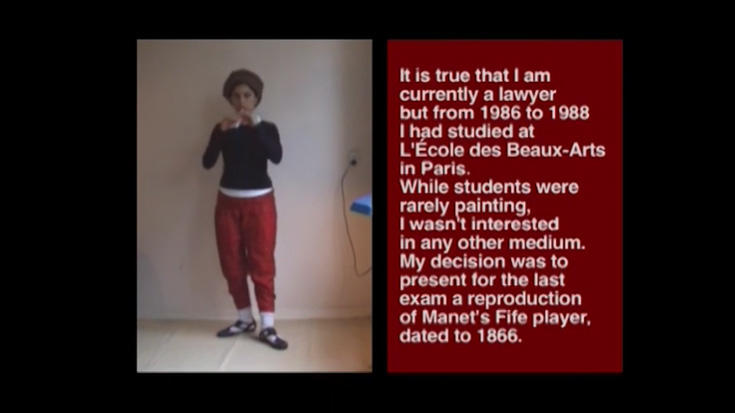
Video
12 min. 8 sec.
Courtesy: Sfeir-Semler Gallery, Beirut/Hamburg
The work depicts the recollections of four artists who have given up their profession. Some of their past works are shown, but these appear somewhat comical with the works employing such cliché - stereotypical means and approaches to contemporary art, such as drawing heavily from classical art works or having a strong similarity to well-known piece of contemporary art. This is likely an expression of Al Solh’s own dilemma with a contemporary art world where artists have to create works, being influenced by particular format, conditions, or trends.
MAM Screen 013: Mounira Al Solh
Period: 2020.7.31 [Fri] - 2021.1.3 [Sun]
Organizer: Mori Art Museum
Curated by: Kondo Kenichi (Senior Curator, Mori Art Museum)
* Exhibition webpage: https://www.mori.art.museum/en/exhibitions/mamscreen013/

